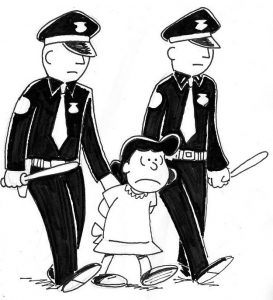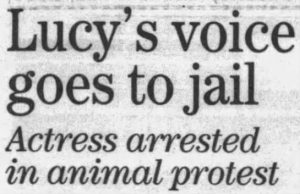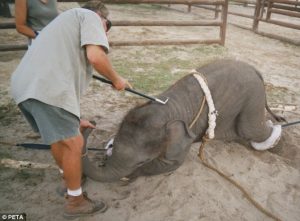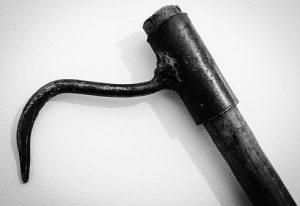 In 1999, I was arrested for bringing a bullhook to a circus protest. Bullhooks resemble a fireplace poker, with a long rod, sharp metal hook and spiked tip. When used on animals, they inflict terrible physical injuries, including lacerations, puncture wounds and abcesses. The cruelty also leads to long-term trauma, emotional distress and suffering for the animals. I brought the bullhook along with pictures of its use on circus animals as a visual aid to educate others. A circus employee, using a bullhook to torture an elephant just a few feet away, was ignored by the police.
In 1999, I was arrested for bringing a bullhook to a circus protest. Bullhooks resemble a fireplace poker, with a long rod, sharp metal hook and spiked tip. When used on animals, they inflict terrible physical injuries, including lacerations, puncture wounds and abcesses. The cruelty also leads to long-term trauma, emotional distress and suffering for the animals. I brought the bullhook along with pictures of its use on circus animals as a visual aid to educate others. A circus employee, using a bullhook to torture an elephant just a few feet away, was ignored by the police.
 I was convicted of violating an obscure L.A. law created during the civil rights era that gave the authorities the right to arrest peaceful protestors by making it illegal to carry wooden sticks (i.e. picket signs) at a demonstration. I lost again on appeal and was sentenced to 30 days in prison. I served my sentence in L.A. County’s Twin Towers Correctional Facility.
I was convicted of violating an obscure L.A. law created during the civil rights era that gave the authorities the right to arrest peaceful protestors by making it illegal to carry wooden sticks (i.e. picket signs) at a demonstration. I lost again on appeal and was sentenced to 30 days in prison. I served my sentence in L.A. County’s Twin Towers Correctional Facility.
For the public attention my arrest and conviction drew to the bullhook, going to jail was well worth it. Growing public condemnation led to a ban on the use of bullhooks in Los Angeles, followed by Oakland, Austin, Pittsburgh, Minneapolis, and Spokane. In 2016, Rhode Island became the first state to ban the instrument of torture and California became the second. In 2019 the Association of Zoos and Aquariums voted to “phase out” the bullhook’s use by the start of 2021. It also approved a statement of intent to completely end the use of bullhooks by 2023.
 While I will be glad to see the end of bullhooks, why, I wonder, when something is finally conceded to be dangerous and wrong, does it require additional years of pain and suffering before a full ban takes effect? We’re not talking about time needed to retool factories to manufacture new products or creating infrastructure for new sources of energy. Just throw away the bullhooks now and end the abuse once and for all.
While I will be glad to see the end of bullhooks, why, I wonder, when something is finally conceded to be dangerous and wrong, does it require additional years of pain and suffering before a full ban takes effect? We’re not talking about time needed to retool factories to manufacture new products or creating infrastructure for new sources of energy. Just throw away the bullhooks now and end the abuse once and for all.

